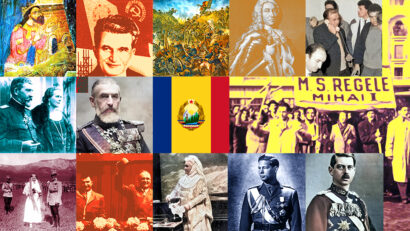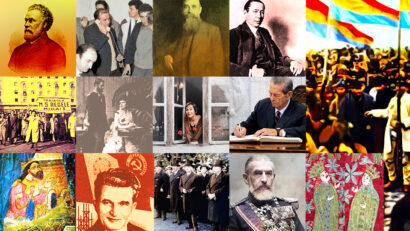The Americans in Romania in the second half of the 1940s
About Romanian-American relations during and post-WWII told through inteviews to Radio Romania's Oral History Centre.

Steliu Lambru, 01.05.2023, 14:00
Romanian-American
relations deteriorated at great speed during WWII. Fighting on
opposite sides, they were adversaries owing rather to circumstance.
Romania had joined Germany in the war to protect itself from the
aggression of the USSR, while the United States were allies with the
USSR because they were fighting together against Germany. Despite
this, Romania and the United States maintained minimal contacts,
which eventually helped them re-establish closer ties. One example
was the camp for American prisoners injured in Romania. Gheorghe M.
Ionescu, who was a member of the National Peasant Party and a
pro-American, was interviewed in 2004 for Radio Romania’s Oral
History Centre about his WWII experience. He described how German
planes from a German military aerodrome in Geamăna, Arges county, in
the centre-south of Romania, intercepted the US aircraft when the
latter began bombing the area:
They
fought in the air above
the village. When the
American
aircraft was hit, eight Americans from the
8-crew
B-26 bomber parachuted themselves. Four died when hitting the ground
and four were injured. The wind had blown them into a forest towards
Cireşu. The civilian defence, the town hall and army troops were all
mobilised and the alarm sounded. We were sent to look for them, but I
didn’t go. The Americans eventually came out of the forest and
turned themselves in. They were
put
on two carts and taken
to the
hospital in Piteşti where they received treatment and recovered.
Showing
lots of fair-play, the Americans thanked the locals for the humane
treatment they had shown to the prisoners. Gheorghe
M. Ionescu:
About
a month later, we heard an announcement on Radio London: Many thanks
to doctor Nelecu, surgeon and the head of the hospital, for the care
and attention he gave to the American soldiers. After they recovered,
the American soldiers were of course sent to the prisoner’s camp in
Predeal, where it must be said that the Romanians treated them well.
They even played tennis there, it was more like a resort than a
prisoner camp, and certainly nothing like those run by the Russians.
The four soldiers who died parachuting themselves were buried in the
cemetery in Lăceni. Each had identification tags with their name,
regiment, age and their civilian data. The Americans had their own
exact records and it couldn’t have been more than a week or ten
days after 23rd
August 1944 that they showed up in the village and exhumed the
soldiers and took them back to Oklahoma where they had their home and
families.
Gheorghe
Barbul, the
personal secretary to marshal Ion Antonescu told the historian Vlad
Georgescu in a talk hosted in 1984 by Radio Free Europe that although
enemies in the war, Romania and the United States were engaged in
negotiation:
The
first direct contact with the Americans was made in Stockholm by
Rădulescu, Mihai Antonescu’s chief of staff. His interlocutor was
a personal observer of Roosevelt in Europe who did have any official
capacity. The US president used this system in order to circumvent
the regular diplomatic channels and not be reproached by allies that
he was conducting separate talks. The result of the Stockholm meeting
was summed up by Mihai Antonescu like this: president Roosevelt is
worried about the line of intersection in Europe between American and
Soviet armies. The news brought back by Rădulescu
had a profound effect in Bucharest. Marshall Antonescu felt he had
been right in believing that by resisting the Russians militarily and
preventing them from entering Europe, he was doing a service not only
to Romania, but also to the Anglo-Americans.
After
Germany’s defeat in 1945 and Romania’s occupation by the Soviet
army, Romania could only hope that the American diplomacy would save
it from the prospect of communism. The myth of the Americans’
landing in the Balkans dates to this time and was, naturally, an
illusion. The Liberal leader Radu Câmpeanu said in an interview in
2000 that the American envoys told Romanian politicians that the US
had very little influence in Romania:
Nicolae
Penescu recounted to me the following episode that took place at the
end of 1944. The National Peasant Party kept its files containing
certain secret records and information with a certain Mr Melbourne.
He was an officer from the American mission who had connections with
the political parties. Melbourne lived in a flat somewhere near
Grădina Icoanei. One time the party needed a document kept by
Melbourne and sent someone to look for it. After consulting the
document, Melbourne invited him to stay for a chat and told him ‘I
must tell you that we have no power here, it’s Moscow who has all
the power. You should try and reach and understanding with them, to
talk to them.’ So he goes back and tells his leader Maniu what
Melbourne had advised. And Maniu put his hand on his and said: we
will do what we believe in’.
Although
history separated them from 1945 until 1989, Romania and the United
States maintained their mutual affinities and after 1989 bilateral
relations returned to their normal course, as was to be expected.





























